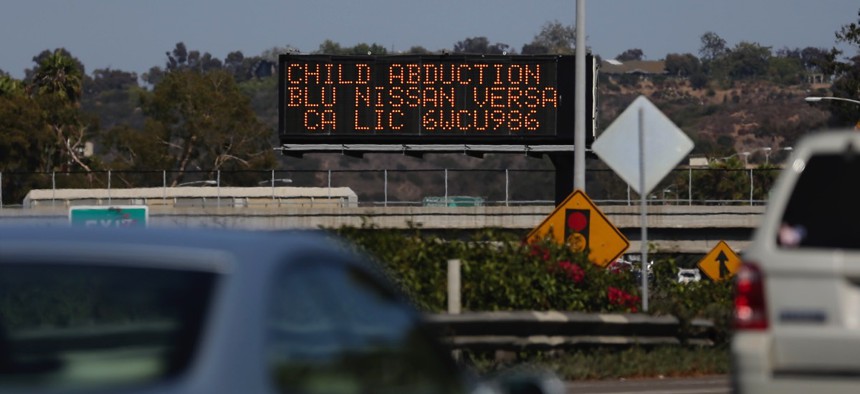The Cloud Is Making It Easier for States and Localities to Issue Alerts in Seconds

Drivers pass a display showing an Amber Alert, asking motorists to be on the lookout for a specific vehicle, on Aug. 6, 2013, in San Diego. Gregory Bull / AP Photo

Connecting state and local government leaders
Time can make all the difference for a kidnapping victim or a family in the path of a tornado.
The Federation for Internet Alerts is increasing the speed at which state and local government agencies can issue storm, natural disaster and kidnapping warnings to citizens with its free, cloud-based Alert Hub.
Amazon Web Services’ cloud scalability has allowed FIA to deliver more than 800 million AMBER Alert impressions during 794 abductions and more than 10 million tornado warnings.
Any global ad-serving platform can access FIA’s alerts in milliseconds, serving alerts in place of ads where geotargeted, for real-time emergency response.
Plano, Texas-based online advertising company Conversent recognized in 2011 that the same technology used to send automated commercial alerts on the internet could also be used to issue dynamic AMBER Alerts with images and detailed information on kidnap victims. So the company partnered with the National Center for Missing and Exploited Children to form the 501(c)(3) nonprofit FIA.
“The advertising technology we were using to serve real-time advertisements was really the perfect combination when you look at the data you get from state and local governments,” Jason Bier, FIA president, told Route Fifty in a phone interview.
By 2013, FIA was receiving AMBER Alert and tornado warning data from the National Oceanic and Atmospheric Administration and National Weather Service, and other organizations had begun joining the federation.
Expanding alerts and how FIA was alerting the public necessitated a move to the cloud.
The Common Alerting Protocol is a digital format enabling exchange of emergency alerts simultaneously across many communications systems—from those used by the United Nations-chartered World Meteorological Organization down to U.S. states and localities. Leveraging it opened up hundreds, if not thousands, of use cases like flood warnings at the municipal level.
CAP provides a standard schema streamlining the flow of data from alerting authorities to FIA subscribers, who use the data. FIA plugs into state and local emergencies, and because AWS has centers all over the world, governments globally can freely consume relevant alert content.
“We use the cloud because we’re volunteers,” said Mickey Schwab, FIA’s vice president of operations.
With limited IT staff, FIA doesn’t need to worry about infrastructure with the cloud or monitoring systems thanks to automatic reboot and auto-scaling. That would’ve taken months to build out, and even then, FIA would’ve lacked AWS’ global footprint.
Security is paramount with such a system, in order to prevent a nefarious organization or individual from creating a malicious alert to, say, issue a fake evacuation order and make residents vulnerable to a terrorist attack in the process.
“There is a serious push to lock down this system,” Schwab said. “I sleep well at night knowing our data is secure.”
Traditionally, data like the kind FIA uses is “fetched” or pulled, but that process is too slow when an earthquake early-warning alert—which can relay a warning that an earthquake has been detected ahead to a city faster than seismic waves can travel—needs to go out immediately. Instead, alerting authorities push data.
Alerts are validated using https, matching them to the transmitting authority’s feed. And Secure Hash Algorithm encryption tech gets alerts, from sensors and other devices, delivered in 80 milliseconds—that’s faster than you can blink—through the cloud.
That kind of response time, sending tornado warnings within 60 seconds, saves lives. Everything is automated, and the cloud never sleeps. So alerts will get where they need to go even at 3 a.m.
Many state and local alerts are pushed through NOAA and NWS, when they’re weather related, but local agencies can issue warnings in their area that are published through the service using CAP.
As alerting technology gets better, elevators are being built to stop when an earthquake alert is issued for their area, and most building alarms and speakers are CAP-based and can read any semblance of text. Residents of an apartment may soon get orders to move to a different floor if theirs is in danger.
Digital displays, including billboards and road signs, connected to the internet will soon be activated by alerts. New York state’s Metropolitan Transportation Authority, which manages bus, subway, commuter rail in and around New York City, is FIA’s latest partner, working together to integrate signage technology that can get alerts to targeted locations when needed.
FIA plans to partner with more transit authorities in the future, using the cloud to expand worldwide. The federation subscribes to hundreds of state and local government alerts, despite not necessarily having working relationships with those jurisdictions, providing information to sources tapping in.
MTA is an FIA subscriber, so, for instance, if the National Weather Service issues a winter weather warning for the New York City area, it will be processed through the Alert Hub and sent to partners like MTA involved in publishing alerts. The alerts could appear internally or be displayed publically on buses
“It’s the government using its own data,” Bier said. “How can we grow innovations and expand alerts to save more lives?”
Dave Nyczepir is a News Editor at Government Executive’s Route Fifty and is based in Washington, D.C.

NEXT STORY: Why Oil and Coal States Are Slashing Their Education Budgets





